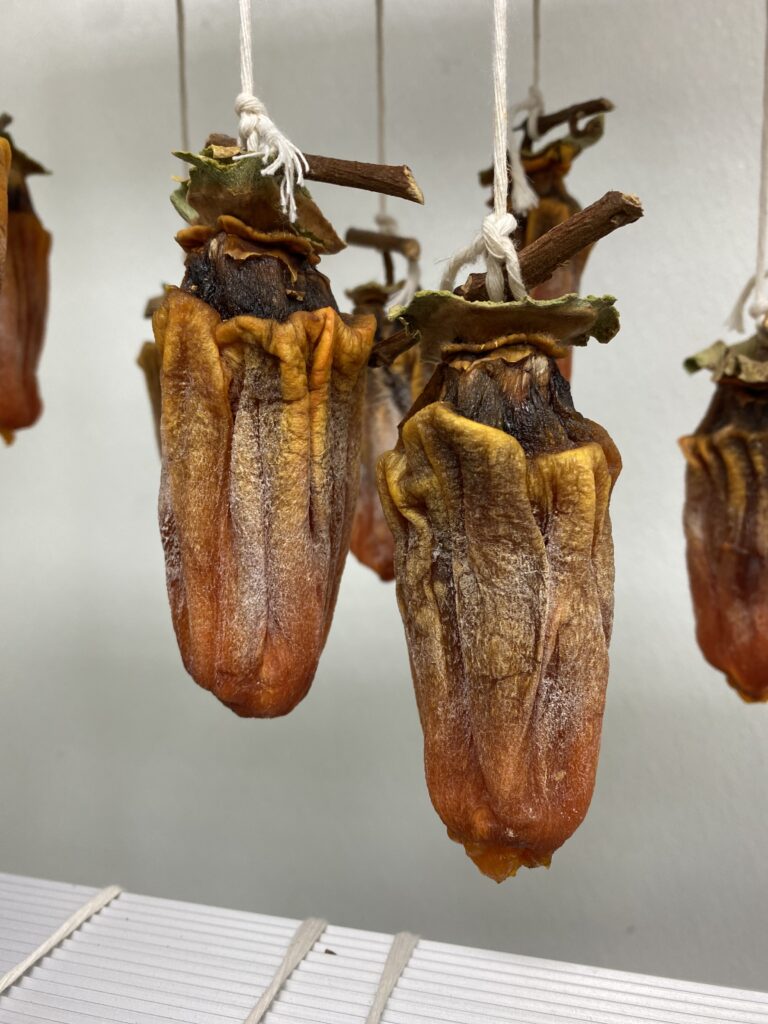Magnus Young, Clif Family Chef de Cuisine
Persimmons are winter classic for many Californians, but not as well known to much of the United States. Their beautiful crimson color and late ripening make them a natural decoration frequently found throughout the Napa Valley. And at Clif Family, it is one fall season favorite that we most look forward to including in wine tasting experiences and in dishes from the Clif Family Food Truck.
At the Clif Family Farm, we grow two types of persimmons, Hachiya and Fuyu. Fuyu persimmons tend to be best enjoyed fresh and you will commonly see them added to salads from our Bruschetteria Frood Truck. Comparatively, Hachiya persimmons are late ripening and have incredibly astringent skins making them better suited for use in baked goods or cooked down into jam. At Clif Family, our culinary team preserves them in a unique culinary process called Hoshigaki. These Hoshigaki will then be used in many of our wine tasting experiences and food truck dishes well into the spring season.
While dried persimmons are common throughout East Asia, the styles will vary from country to country. At Clif Family, we utilize the Japanese technique air drying Hachiya persimmons, known as Hoshigaki. Traditionally, the Japanese would use this process to preserve the fruit for the winter season and allow them to be consumed all year long. While the procedure may seem labor intensive, the process of making Hoshigaki is really quite simple and can be rewarding for months past the winter season.
HOW TO MAKE HOSHIGAKI
It’s best to use Hachiya persimmon (acorn shaped vs. squatty tomato shaped) for this process. They should still be hard but deep orange in color. If they are still green, they are not ready. Find a desirable place to hang them, ideally a cool, dry location. Set up a fan to blow across this location for convection. This will improve results and keep fruit flies and other pests away.
Prep the Persimmons
If harvesting the persimmons yourself, cut the persimmon from the tree leaving a bit of the branch in a “T” shape at the stem. This makes hanging them easier. If not, use an eye bolt and screw in the top of the persimmon where the stem would sit. Make sure to screw down at least 1” deep. Remove all leaves and peel the persimmons.
String the Persimmons
Tie a piece of kitchen twine to the stem or eye bolt to allow each persimmon to hang. Then tie each persimmon to an anchor where they can hang for a few weeks.
Place a Fan
On a low to medium setting, adjust the fan to blow directly over the hanging persimmons. The fan speed should be set just high enough for a light breeze. If your fan only has one setting, position the fan a bit further away from the persimmons. If a fan is not available, a well-ventilated area with an air current will also work.
Massage
Allow persimmons to hang in the constant breeze for about 4-6 weeks. After about 3 days, you’ll notice a “skin” has started to form on the outsides. As the persimmons continue to hang, they will dehydrate, shrivel and create a sugary, powdery skin on the outside that acts as a natural preservative and is safe to eat. The internal pulp will also begin to break down.
Once a sugar skin has started to form, you can begin massaging them. Gently massage the persimmons with your thumbs to evenly distribute the pulp throughout and to slowly flatten over time. Repeat this process of massaging the persimmons every couple of days through the entire drying process.
Waiting Game
After about 4-6 weeks, the persimmons should be ready. You’ll see a powdery, crystalline appearance over the exterior (this is perfect!) and the persimmons will have flattened. Remove the persimmons from their strings and transfer to an airtight container between layers of parchment or wax lined paper to prevent them from sticking together. These can be held in the refrigerator for up to 1 year.

CULINARY USES
Hoshigaki are great enjoyed on their own just as you would any other dried fruit snack. We like to slice them and add to winter cheese boards along with walnuts, pecans and chestnuts. We find Hoshigaki is best paired with our Clif Family Oak Knoll District Sauvignon Blanc or Unoaked Chardonnay.
Hoshigaki uses don’t have to end with cheese boards! There are many other fun culinary uses.
• Small dice them and use as an inclusion in pastries or seasonal fall salads
• Small dice and add to oatmeal
• Add to quinoa or couscous middle eastern inspired salads
• Simmer with some sugar and vinegar to make a persimmon agrodolce
• Cook down with vinegar, sugar and mustard seeds to make a persimmon mostarda and pair with roast pork loin.
• Simmer in brandy or bourbon and enjoy over vanilla ice cream
• Rehydrate them with a little warm water and then blend them smooth to make a rich complex puree that can be used in place of pumpkin puree for Winter themed desserts
Cheers to Hoshigaki season!










1 Comment